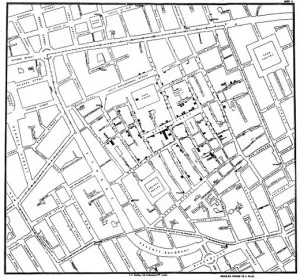Cholera, John Snow and the Grand Experiment
A British physician first determined that cholera spread through contaminated water in the 1850s, but the disease remains a major health risk today
/https://tf-cmsv2-smithsonianmag-media.s3.amazonaws.com/filer/20110520102403643px-Snow-cholera-map-1-300x279.jpg)
I started reading about cholera over the weekend after hearing that health officials had confirmed several cases of the disease among victims of the recent Pakistani floods. Cholera is a bacterial disease that produces diarrhea and vomiting; people with the disease can die within hours if they don't get treatment. About 3 million to 5 million people suffer from cholera each year, mostly in developing countries, and 100,000 die from it, according to the World Health Organization.
This led me to the history of cholera and John Snow. Snow is credited with the discovery that cholera is transmitted through sewage-tainted water. His map of London's Soho region is often reproduced in biology textbooks with the story of how he made his discovery. Snow mapped out the cases of cholera during an 1854 outbreak and determined where each of the infected families obtained their water.

He would later write:
I found that nearly all the deaths had taken place within a short distance of the pump. There were only ten deaths in houses situated decidedly nearer to another street-pump. In five of these cases the families of the deceased persons informed me that they always sent to the pump in Broad Street, as they preferred the water to that of the pumps which were nearer. In three other cases, the deceased were children who went to school near the pump in Broad Street...
With regard to the deaths occurring in the locality belonging to the pump, there were 61 instances in which I was informed that the deceased persons used to drink the pump water from Broad Street, either constantly or occasionally...
The result of the inquiry, then, is, that there has been no particular outbreak or prevalence of cholera in this part of London except among the persons who were in the habit of drinking the water of the above-mentioned pump well.
The Broad Street well, Snow concluded, was contaminated with cholera (it was later found to have been built near an old cesspit). The well's pump handle was removed and the cholera outbreak ended. This is where most textbooks end. But there's a second part to the story—Snow's Grand Experiment.
There were parts of London that received their water from two distinct sources, the Southwark-Vauxhall Company and the Lambeth Waterworks Company. This was an ideal set-up for Snow for an experiment. Both companies drew water from the Thames, but Lambeth's intake was farther upriver—and thus less likely to be contaminated with the city's sewage—than Southwark-Vauxhall's.
Snow compiled data on the two sets of London households and found that during an 1854 epidemic there were 315 deaths from cholera per 10,000 homes among those supplied by Southwark-Vauxhall but only 37 deaths per 10,000 Lambeth homes.
That would seem to be a slam dunk in the research world, but Snow had gotten his numbers not from an extensive house-to-house search, which would have been too much work for even a team of men, but from a less-precise parliamentary report. Neither Snow nor many of his detractors believed his results were strong enough to make the case that cholera was related to water supply.
A few years ago, Thomas Koch and Kenneth Denike, of the University of British Columbia, re-evaluated the Grand Experiment and found even more problems with his methods and statistics. “The grand experiment ... was a failure,” Kock recently told The Scientist.
The irony, of course, is that Snow was right. As cities cleaned up their water supplies over the subsequent decades, cholera ceased being such a problem. But with more than a billion people worldwide lacking access to clean drinking water, the disease will remain with us for years to come.
/https://tf-cmsv2-smithsonianmag-media.s3.amazonaws.com/accounts/headshot/Sarah-Zielinski-240.jpg)
/https://tf-cmsv2-smithsonianmag-media.s3.amazonaws.com/accounts/headshot/Sarah-Zielinski-240.jpg)